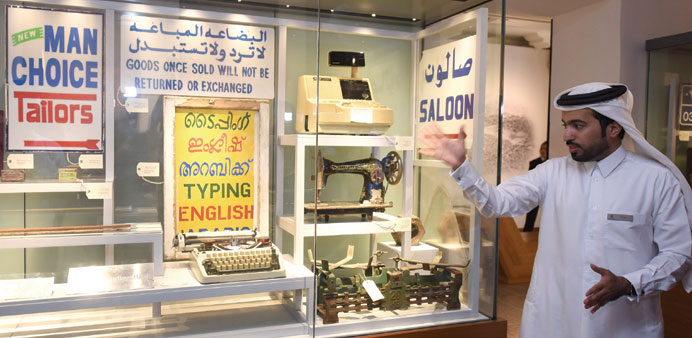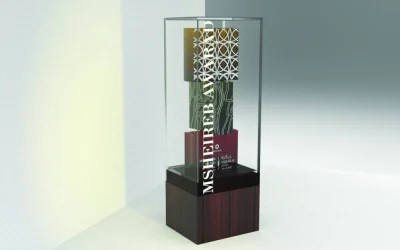A museum staff shows some of the old items displayed at Mohamed bin Jassim House. PICTURES: Noushad Thekkayil
By Joey Aguilar
Staff Reporter
Four heritage buildings – Mohamed bin Jassim House, Radwani House, Company House, and Bin Jelmood House – form part of Msheireb Museums which tell stories of human perseverance and hard work, and how domestic family life was transformed in Doha before and after the discovery of oil in the country.
Part of the QR20.4bn Msheireb Downtown Doha (MDD) project, the museums use modern technology to narrate and share some of the ‘great tales’ of Qatar’s past and continue to document oral history from people who want to share their stories.
At a recent media tour, Msheireb Museums manager Hafiz Ali Ali underscored the need to honour the hardships and struggle of their ancestors who worked in Dukhan to build Qatar’s economy.
“This is how we built the museum (Company House), to tell the story and to narrate how these people had changed our lives,” he said.
The Company House features a panoramic cinema which uses a first-of-its-kind technology in screening documentaries and films that highlight the significant role of those who sacrificed and worked hard to develop the country.
A section of the museum also features a pipeline depicting a timeline of events that took place before and after the discovery of oil in Qatar.
Faced by many challenges and setbacks at the work site, Ali said the Qatari pioneers had shown remarkable dedication as they build a better future for their countrymen especially to their families.
“There was a part or a time of despair, very hard to make a living until the oil was discovered,” he noted.
One section of the museum is dedicated for old items and equipment brought by the British such as typewriters, telephone sets, stationery, and different kinds of tools. It also displays parts of the first generator brought to Qatar.
“We want people to come and see. A lot of changes had happened when the British came - food culture, games and so many things that we want to talk and educate our kids,” he said.
The ambience at Radwani House is much different compared with the three other museums. Built in the 1920s and located between Al-Jasrah and Msheireb, it presents traditional Qatari family life.
Ali said they designed the gallery without any air conditioners to give visitors a real feel of how families and residents before had lived in these houses.
A sewing machine is also displayed in one of the rooms, an item that is normally seen in a typical Qatari house.
“Sewing machine is a real hero for me. When I was kid I always used to see my mother sew our own clothes,” Ali recounted.
One room is air conditioned to depict the era in the late 50’s when electricity came to Doha. The first television set and radio are also displayed.
Ali stressed added that a key element of old Qatari houses is the courtyard.
The Bin Jelmood House was built to raise awareness and play a significant role in abolishing human exploitation worldwide. The museum tells stories of human sufferings throughout the Indian Ocean.
A large glass frame with a portrait and message from HH Sheikha Moza bint Nasser welcomes visitors to the galleries and says: “Freedom is not an attribute specific to just one civilisation, but it is a human value, one that I believe is the driving force behind the making of human history.”
Bin Jelmood House also provides an opportunity for visitors to make a personal commitment to joining the fight against human exploitation in all its many manifestations.
For those who want to travel back in time to understand Doha’s past and its unique architectural heritage, the Mohamed bin Jassim House is the right place to visit.
The museum houses the Echo Memory Art Project using objects uncovered during excavation work on the site.
One section features some of the items used by residents and families back then such as combs, scissors and creams (for shaving) in barbershops, as well as chalk boards in classrooms.



